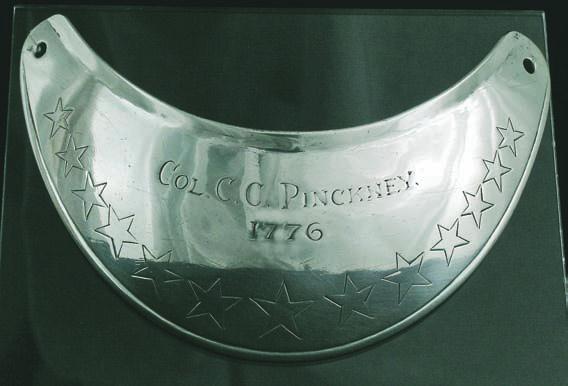 Wednesday I came upon an interesting read from the folks at COLAToday.com. As much as I like to think I know about our state, the debate about the crescent moon on the South Carolina State flag is not one of them. I knew about the controversy regarding the tree not being ‘uniform’ on all flags and schwag, but always thought the symbol in the corner was a moon and never questioned it or heard any differently.
Wednesday I came upon an interesting read from the folks at COLAToday.com. As much as I like to think I know about our state, the debate about the crescent moon on the South Carolina State flag is not one of them. I knew about the controversy regarding the tree not being ‘uniform’ on all flags and schwag, but always thought the symbol in the corner was a moon and never questioned it or heard any differently.
It’s thought-provoking, actually. Think of all the businesses in The Palmetto State that are named in honor of the crescent moon. Thinking further, what of the Order of the Silver Crescent? Should that not be a thing? (For context: The Order of the Silver Crescent was initiated by Governor David Beasley in 1997 as a companion award to the Order of the Palmetto and was intended to honor the achievements of South Carolinians aged eighteen or younger. In May 1999 Governor Hodges determined that the Silver Crescent would be awarded to persons of any age for exemplary community contributions and achievements. Each honoree received a certificate decorated with a large crescent moon, signed by the governor, and bearing the governor’s seal of office.)
Either way below is a good read. Thanks to the folks at COLAToday.com for the conversation!
Franklin Jones
Here’s the thing: as is often the case when it comes to history – we’ve lost track of some of it. And now, modern-day historians disagree on what we’re actually looking at when it comes to the state flag.
Confused? Don’t worry – we’ll explain.
The story begins with one man: Colonel William Moultrie. From his fort on what is now Sullivan’s Island (near Charleston), Moultrie defended the Charleston Harbor from British warships.

For nine grueling hours on June 28, 1776, British battleships pounded the Lowcountry’s Fort Sullivan with cannon fire – but to no avail. That’s because its walls were fortified with palmetto logs – which absorbed the force from the cannonballs, rather than shattering.
Eventually, the Redcoats withdrew. Of course, they did go on to carry out a successful siege of Charleston – but thanks to the fierce protection by the palmetto logs, today, Fort Sullivan (now Fort Moultrie) was still standing by the end of the Revolutionary War.
How does that play into the story of our state flag, you ask? Two ways. One – because the life-saving work of the palmetto logs can be attributed in the sabal palmetto ultimately being designated South Carolina’s State tree. And two – because Colonel Moultrie designed a flag that hung at Fort Sullivan– one that eventually inspired the design of the state flag.
The Fort Moultrie Flag

Col. Moultrie chose blue to be the color of the flag so that it would match the color of his soldiers’ uniforms.
The crescent, with the word “liberty” written across it, also paid homage to their uniforms: their caps were adorned with silver crescents, along with the words “Liberty or Death.” (Or was it a gorget? More on that below.)
Does this all look familiar? It should. After the war ended, state leaders used this flag as a basis for the design of the official state flag in 1861. The word ‘liberty’ was taken out, and, of course, the palmetto tree was added.
Crescent Controversy

The crescent, positioned over in the top left corner, seems to welcome the comparison of a moon shining over a palmetto tree. But a lot of people will tell you that it’s not a moon at all– but a crescent-shaped piece of armor worn across the throat called a “gorget.”
Some argue that the gorget symbol was worn on the hats of soldiers as a way of paying tribute to the days of wearing body armor. And being that the crescent symbol on the flag was taken from the uniforms, that would mean the symbol on the flag is also a gorget – not a moon.
Historians have scoured records from the time in an attempt to identify the object, once and for all. They even read Col. Moultrie’s diary in the hopes it would shed some light on the mystery – but even in his most private confessions, Moultrie only referred to the symbol as a “crescent.”
50 Shades of Gray Areas

Believe it or not, the crescent isn’t the only point of contention on the flag.
As lawmakers never established any official guidelines on what the flag should look like, there isn’t a universally accepted design. The consequence of having no solidified design is that the position, placement, size + color of the symbols varies depending on the flag maker.
Lawmakers even reviewed the issue this year – after it was brought to their attention by Newberry-based political consultant Scott Malyrerck. But the session ended last month, without any flag-related legislation reaching the Senate floor.
I’ve grown up thinking of the state flag as bearing a palmetto tree + a crescent moon, and never realized that the issue was up for debate. It’s an interesting theory for sure, but I think I’m still on Team Crescent Moon.



Speak Your Mind